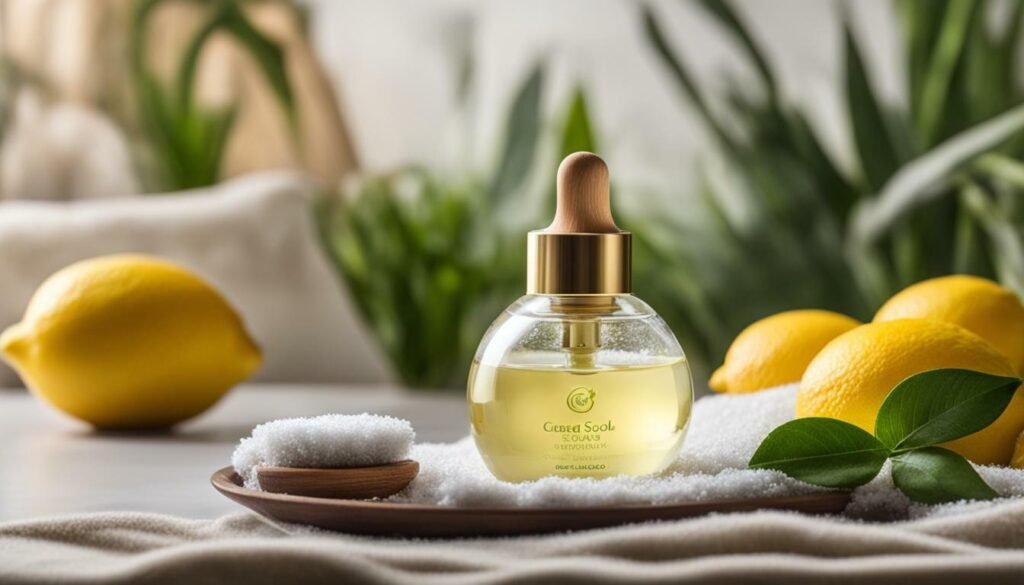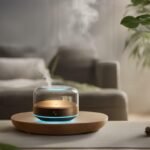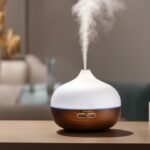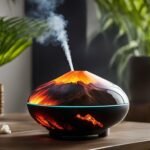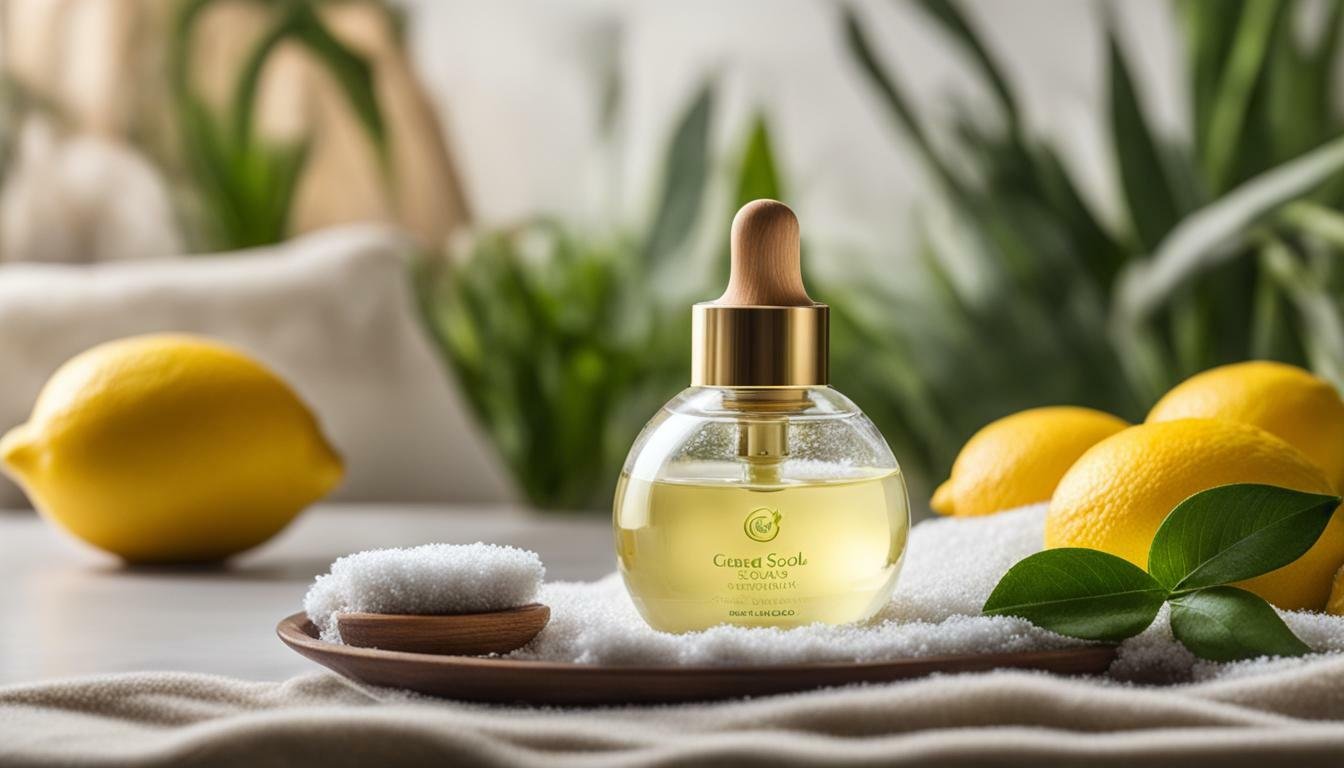
Cleaning an oil diffuser without vinegar is a great alternative for those who prefer to avoid its strong smell. In this section, I will share tips and techniques to help you maintain a fresh and clean oil diffuser using alternative solutions.
To clean your oil diffuser without vinegar, you can use liquid castile soap instead. Vinegar is a common cleaning agent, but it can leave a lingering smell that some people find unpleasant.
Start by doing a quick clean after each use and when changing oils. Unplug the diffuser and pour out any water in the reservoir. Use a microfiber cloth to wipe the inside of the diffuser and a cotton swab dipped in rubbing alcohol to clean the plate at the bottom.
For a deep clean, unplug the diffuser and remove all the parts. Fill a bowl with warm water and a few drops of castile soap. Use a microfiber cloth or a soft brush to clean the parts, making sure to reach all the nooks and crannies. Rinse with distilled or filtered water and dry thoroughly before reassembling the diffuser.
Regular cleaning is essential to prevent oils from breaking down plastic and to maintain the effectiveness of your diffuser. By using alternative cleaning solutions like castile soap, microfiber cloth, and rubbing alcohol, you can keep your oil diffuser in top condition.
Now that you know how to clean an oil diffuser without vinegar, you can enjoy the benefits of a fresh and fragrant home without any unpleasant smells. Follow these tips and techniques regularly to ensure your diffuser continues to disperse fragrance effectively and efficiently.
Quick Cleaning After Each Use
After each use of your oil diffuser and when changing oils, it’s important to perform a quick cleaning routine to ensure its longevity and effectiveness. By following these simple steps, you can keep your diffuser in top condition:
- Unplug the diffuser and carefully pour out any remaining water from the reservoir.
- Take a microfiber cloth and gently wipe the inside of the diffuser to remove any residue or oil build-up.
- Dip a cotton swab in rubbing alcohol and use it to clean the plate at the bottom of the diffuser, which can accumulate oil and affect its performance.
- Allow all parts to air dry before reassembling the diffuser.
By incorporating this quick cleaning routine into your oil diffuser maintenance, you can ensure that it continues to function optimally and provide you with the desired aromatherapy experience.
| Materials Needed: | Steps |
|---|---|
| Microfiber cloth | Unplug the diffuser and pour out any water. |
| Cotton swab | Wipe the inside of the diffuser with the cloth. |
| Rubbing alcohol | Use the cotton swab to clean the plate at the bottom. |
Additional Tips:
- Perform the quick cleaning routine every time you change oils to prevent scent mixing.
- Ensure the diffuser is completely dry before adding new oils to avoid diluting their potency.
- Keep a regular schedule for deep cleaning to maintain the diffuser’s effectiveness.
By incorporating these cleaning practices into your oil diffuser routine, you can enjoy the benefits of essential oils without the need for vinegar and ensure that your diffuser remains clean and efficient.
Deep Cleaning Method
For a more thorough cleaning of your oil diffuser, follow these steps for a deep clean that will help maintain its performance:
- Unplug the diffuser and remove all parts, including the reservoir, lid, and any other removable components.
- Fill a bowl with warm water and add a few drops of liquid castile soap. Mix the water and soap together.
- Dip a microfiber cloth or a soft brush into the soapy water and use it to clean the diffuser parts. Pay special attention to any areas with residue or buildup.
- Rinse each part with distilled or filtered water to remove any soap residue.
- Dry the parts thoroughly with a clean towel or allow them to air dry before reassembling the diffuser.
By following these steps, you’ll ensure that your oil diffuser is clean and free of any oils or residue that could affect its performance. Regular deep cleaning will help maintain the effectiveness of the diffuser and prolong its lifespan.
| Materials Needed: | Instructions: |
|---|---|
| Warm water | Unplug the diffuser and remove all parts. |
| Liquid castile soap | Mix a few drops of liquid castile soap with warm water in a bowl. |
| Microfiber cloth or soft brush | Dip the cloth or brush into the soapy water and clean the diffuser parts. |
| Distilled or filtered water | Rinse each part with clean water to remove soap residue. |
| Clean towel | Dry the parts thoroughly before reassembling the diffuser. |
Remember to deep clean your oil diffuser regularly to prevent the oils from breaking down the plastic components and to ensure optimal performance. By using this method and maintaining a clean diffuser, you can continue to enjoy the benefits of your oil diffuser for a long time to come.
Importance of Regular Cleaning
Regular cleaning of your oil diffuser is essential not only to keep it in optimal condition but also to prevent any potential damage caused by the oils. Oils have the tendency to break down plastic over time, leading to the deterioration of the diffuser. By incorporating regular cleaning into your routine, you can ensure the longevity and effectiveness of your oil diffuser.
To maintain the cleanliness of your diffuser, it is recommended to perform a quick clean after each use and when changing oils. This simple step helps prevent residue build-up and keeps the diffuser functioning properly. Start by unplugging the diffuser and emptying any remaining water from the reservoir.
Next, use a microfiber cloth to wipe the inside of the diffuser, ensuring that all oil residues are removed. Additionally, clean the plate at the bottom of the diffuser by dipping a cotton swab in rubbing alcohol and gently wiping it. These small yet important steps help maintain a clean and fresh diffuser.
For a more thorough clean, it is advisable to periodically perform a deep cleaning. Begin by unplugging the diffuser and carefully disassembling all its parts. Fill a bowl with warm water and a few drops of liquid castile soap. Using a microfiber cloth or a soft brush, clean each part of the diffuser in the soapy water, making sure to remove any oil build-up. Rinse with distilled or filtered water and allow the parts to fully dry before reassembling the diffuser.
| Quick Clean Steps: | Deep Clean Steps: |
|---|---|
|
|
By following these cleaning practices and incorporating them into your routine, you can ensure that your oil diffuser remains in optimal condition, free from potential damage caused by oil residues. Regular cleaning not only promotes the longevity of your diffuser but also helps maintain its effectiveness in dispersing fragrance throughout your space.
Alternative Cleaning Solutions
If you’re looking for alternative cleaning solutions for your oil diffuser, there are a few options available that can effectively remove residue and maintain its cleanliness. One option is to use liquid castile soap, which is a natural and gentle cleanser that can effectively break down oils and dirt without leaving any unwanted smells. Add a few drops of liquid castile soap to warm water and use a microfiber cloth or soft brush to clean the interior and exterior of your diffuser. Rinse with distilled or filtered water and dry before using again.
Another alternative cleaning solution is to use a microfiber cloth. Microfiber is known for its excellent cleaning properties and can easily remove oils and residue from the surface of your diffuser. Simply wet the cloth with warm water and gently wipe down the diffuser, making sure to pay extra attention to any areas with visible dirt or buildup. Microfiber cloths are reusable and can be washed after each use, making them a cost-effective and eco-friendly cleaning option.
If you prefer a stronger cleaning agent, rubbing alcohol can be used to effectively sanitize your oil diffuser. Dip a cotton swab in rubbing alcohol and gently wipe down the plate or any other areas that may be dirty or sticky. Rubbing alcohol is a powerful disinfectant that removes bacteria and germs, ensuring that your diffuser remains hygienic and safe to use. Be sure to let the diffuser dry completely before using it again.
| Alternative Cleaning Solutions | Instructions |
|---|---|
| Liquid Castile Soap | Add a few drops of liquid castile soap to warm water. Use a microfiber cloth or soft brush to clean the diffuser, inside and out. Rinse with distilled or filtered water and dry before use. |
| Microfiber Cloth | Wet a microfiber cloth with warm water and gently wipe down the diffuser. Pay extra attention to areas with visible dirt or buildup. Wash the cloth after each use. |
| Rubbing Alcohol | Dip a cotton swab in rubbing alcohol and wipe down the plate or any dirty areas. Let the diffuser dry completely before using. |
These alternative cleaning solutions provide effective ways to clean your oil diffuser without using vinegar. By regularly maintaining and cleaning your diffuser, you can ensure that it remains in optimal condition and continues to disperse the desired fragrance effectively.
Conclusion
In conclusion, cleaning an oil diffuser without vinegar is possible and can be achieved using alternative cleaning solutions. Regular maintenance is crucial to keep your diffuser in top condition and ensure its longevity. Vinegar is a commonly used cleaning agent, but its strong smell may not be preferred by everyone. Luckily, there are other effective options available.
For a quick clean after each use and when changing oils, start by unplugging the diffuser and emptying the reservoir of any water. Use a microfiber cloth to wipe the inside of the diffuser, ensuring there is no residue left behind. To clean the plate at the bottom, dip a cotton swab in rubbing alcohol and gently wipe it clean. This will help maintain the functionality of the diffuser.
For a deep clean, it is important to unplug the diffuser and carefully remove all parts. Prepare a bowl of warm water with a few drops of liquid castile soap. Using a microfiber cloth or a soft brush, clean each part thoroughly in the soapy water. Make sure to rinse the parts with distilled or filtered water to remove any soap residue, and allow them to dry completely before reassembling the diffuser. This deep cleaning method ensures that any build-up and residue are effectively removed from the diffuser.
Regular cleaning of your oil diffuser is essential to prevent the oils from breaking down the plastic components and to maintain the effectiveness of the diffuser in dispersing fragrance. By following these alternative cleaning solutions, you can keep your oil diffuser clean and fresh, without the use of vinegar. Remember to always read the manufacturer’s instructions for specific cleaning recommendations for your diffuser.
FAQ
How can I clean an oil diffuser without vinegar?
You can use liquid castile soap as an alternative cleaning agent.
What is the quick cleaning method after each use?
After each use or when changing oils, unplug the diffuser, pour out any water, wipe the inside with a microfiber cloth, and use a cotton swab dipped in rubbing alcohol to clean the plate at the bottom.
How do I perform a deep clean of the oil diffuser?
For a deep clean, unplug the diffuser, remove all parts, fill a bowl with warm water and a few drops of castile soap, clean the parts with a microfiber cloth or soft brush, rinse with distilled or filtered water, and dry before reassembling.
Why is regular cleaning of the oil diffuser important?
Regular cleaning prevents oils from breaking down plastic and helps maintain the diffuser’s effectiveness in dispersing fragrance.
Are there any alternative cleaning solutions to vinegar?
Yes, liquid castile soap, microfiber cloth, and rubbing alcohol can be used as effective alternative cleaning solutions for the oil diffuser.
Is there anything else I need to know about cleaning an oil diffuser without vinegar?
Regular cleaning and using alternative solutions ensure the longevity and optimal performance of your oil diffuser.

